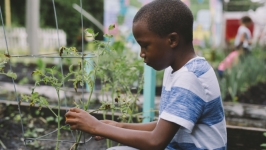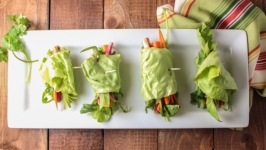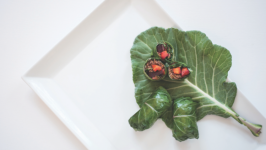Kids in the Kitchen: Learning to Cook (and Eat) Veggies
After hearing from other moms that one of their toughest challenges was getting kids to eat their veggies, Dawn Hutchins, founder of Florida Coastal Cooking & Wellness, decided it was time to take action. In 2016, she launched VegeCooking, an after-school enrichment program with a mission to “teach kids to learn to cook and love their veggies.”
Hutchins takes a broad approach to educating children on the importance of eating real food. In addition to cooking instructions, VegeCooking’s curriculum incorporates science, history and multiculturalism. For instance, a class may discuss what kids in other countries eat for lunch or a science project to build mini volcanoes out of salt dough, vinegar and baking soda. Hutchins partners with Heather Borders, Registered Dietician and founder of Kailo Nutrition, to include nutrition information for every class. VegeCooking promotes sustainability by composting scraps, incorporating local and seasonal ingredients and avoiding single-use plastics.
The VegeCooking recipes are adaptable to food allergies and, because of its specific storage and preparation requirements, meat generally does not make an appearance on the menu. However, “we aren’t anti-anything,” Hutchins says of VegeCooking’s philosophy. “Our focus is simply to teach the benefits of adding more plant food to [the children’s] diets.”
Borders remarks that lack of fiber - an issue characteristic of the American diet - is “directly related to the struggle to manage weight, cholesterol, blood pressure, diabetes, and other common conditions.” Adding fibrous fruits, vegetables, whole grains and beans to a child’s diet builds healthy eating habits, allows them to choose wholesome food options they may not have considered before, and “ensures they are getting the nutrients needed to support their development” says Borders.
Students are not required to taste something if they don’t want to. Michelle Smith, VegeCooking instructor, says students are hesitant to try things like nutritional yeast and kale. But, Hutchins points out, students are encouraged when they see their peers trying and enjoying new foods. Parents report that, after attending VegeCooking classes, their children are more likely to help in the kitchen and try new fruits and vegetables.
During class, students work in small teams and complete different parts of the recipes. Then they come together to assemble and taste the final product. Smith says that mindfully preparing healthy food enforces that meals can be “a way of taking care of ourselves in a busy world” and a way of taking care of each other.
During one session, the class was preparing yogurt and fruit parfaits and a student with allergies couldn’t eat the granola called for in the recipe. His classmates collectively decided they wouldn’t eat the granola either.
“That show of empathy and kindness was priceless,” says Smith.
***********
Want to learn more about ways to get kids in the kitchen? Contact Dawn Hutchins at VegeCooking for classes on cooking and nutrition.










